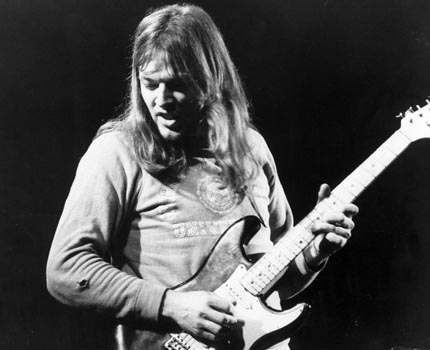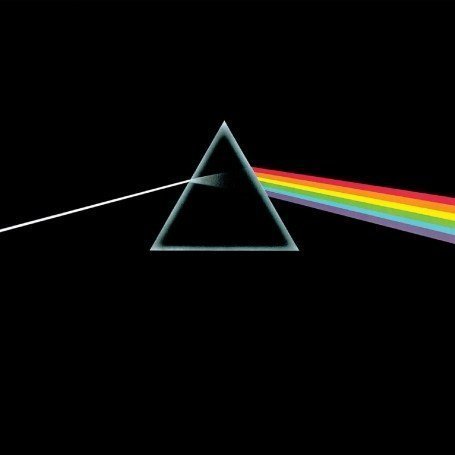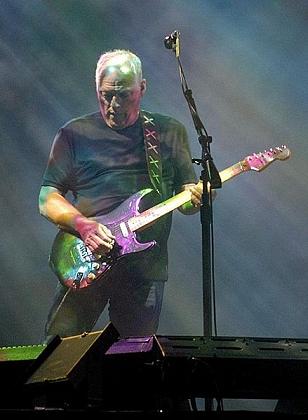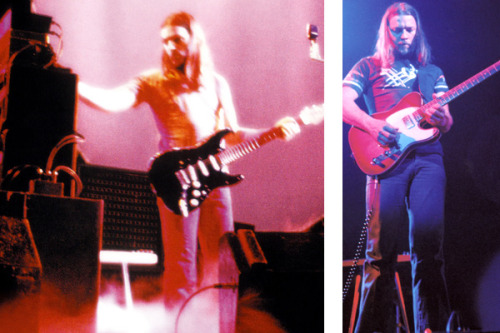At #25, a guitarist whose whose melodic solos gave life to a group's songs, and a guitarist whose talent and expression made him equally adept at playing slow ballads or funky riffs.
David Jon GIlmour was born March 6, 1946 in Cambridge, England. He was one of the lead singers and main songwriters in addition to being the lead guitarist and multi-instrumentalist of Pink Floyd.

Gilmour went to the Perse School in Cambridge. He met future lead singer and guitarist Syd Barrett and bassist Roger Waters, who went to the Cambridgeshire High School for Boys nearby. Gilmour learned to play the guitar and joined the band Joker's Wild in 1962. Gilmour left that band in 1966 to do street performances (busking) in Spain and France. That was not successful so in 1967, Gilmour returned to England.
In December, 1967, drummer Nick Mason of Pink Floyd asked Gilmour to join the group, which he did in January, 1968. David immediately went out and bought a custom-made yellow Fender Stratocaster, and the guitar became one of his favorites throughout his career. Barrett often was unable to perform live to his use of drugs and David filled in for him on lead guitar. Finally, the group had had enough of Barrett and Gilmour assumed not only lead guitar but most of the lead vocals as well. The group formally announced the departure of Barrett on April 6, 1968 although for a short period afterwards Barrett still showed up at a few gigs, apparently confused about what was happening.

Pink Floyd set out to record their second album at Abbey Road Studios in London. A Saucerful of Secrets was released in June 1968 and the group performed at the first free Hyde Park concert. Pink Floyd also went on their first major tour of the United States, accompanied by the Who.
Pink Floyd recorded the score for the movies The Committee in 1968 and More in 1969. A tour of the U.K. ended at the Royal Festival Hall, when an electric shock caused by poor grounding sent Gilmour flying across the stage.

The double-LP Ummagumma contained live performances and older songs the group had written. Atom Heart Mother quickly followed in the second half of 1970. Atom Heart was their first recorded using an eight-track system. The album was popular in the U.K., although Gilmour and Waters did not like it. Pink Floyd toured throughout America and Europe to promote it.
After the tour was over, Pink Floyd began working on new material. They spent several days at Air Studios, using household objects to create music, a project they would use later in their career as well. The group recorded Meddle in stages, doing a good deal of touring throughout Europe and Australia in between. Meddle was released in October of 1971 while Pink Floyd were touring the United States. It was on this album that Gilmour's guitar became a driving force behind the group. It was the first album to reach the Top 50 in the U.S.
The next album was recorded between May 1972 and January 1973 with EMI staff engineer Alan Parsons at Abbey Road. Producer Chris Thomas provided key assistance. The theme of the album dealt with lunacy and the extreme behaviors of the human race and the album was called The Dark Side of the Moon. Pink Floyd filmed studio footage for Pink Floyd: Live at Pompeii before doing a tour of Europe.

The Dark Side of the Moon was released in March 1973 and achieved instant success, reaching #1 on the album chart. Pink Floyd featured the album in performances in the United States. The album toppled Carole King's Tapestry for the longest-running album on the charts with a total of 741. To date, over 50 million copies have been sold and it placed ninth on Inside the Rock Era's list of The Top 100 Albums of the Rock Era* in 2011. Despite Capitol Records doing a superb job of promoting the album, Pink Floyd signed a new contract with Columbia.
Pink Floyd returned to the studio in January 1975. The group was emotionally and physical drained from The Dark Side of the Moon. Everything they had dreamed of: money, fame, success...had been reached. After some time, Waters came up with the concept of an album devoted to Syd Barrett, their former frontman. The album would detail the rise and fall of Barrett and much of Wish You Were Here was premiered at the Knebworth Festival in July before being released in September. The album reached #1 on both sides of the Atlantic.
In 1975 and 1976, Pink Floyd recorded Animals, their eighth studio album. The album debuted in 1977 on the U.K. chart at number two and at #3 in the United States. The subsequent tour showed signs of the group not getting along. Gilmour, who resented large crowds, actually spat on a fan in the front row who was especially noisy.

After Animals, Gilmour believed his musical talents were being underused and recorded his first solo album in 1978. The album did fairly well, but finances that had been gambled in high-risk venture capital schemes were losing money and the band was paying an 83% tax rate.
Pink Floyd began working on their new album in the summer of 1978 with the loose title Bricks in the Wall. The title was inspired by Gilmour'sThe Top 20 Albums of the Rock Era* by Inside the Rock Era.

Pink Floyd won the Grammy for Best Engineered Non-Classical Album for The Wall and the group toured with an elaborate stage show, including animations and large inflatable puppets. But the tour lost $600,000 as ticket sales did not keep pace with the expense of the operation. A movie of The Wall was also made and released in 1982.
Gilmour felt that Pink Floyd's new album should contain all new material, rather than that considered not good enough for The Wall. Waters, who had become the chief songwriter by now, disagreed and there were many arguments. Waters felt that Gilmour had not contributed much in the way of lyrics.
The group commenced recording the album in eight different studios. Waters and Gilmour worked separately. After another confrontation, David's name as producer was taken off the list of credits, because Waters didn't feel he had contributed enough. The Final Cut was released in 1983, going to #1 in the U.K. and #6 in the United States.

The negative atmosphere around the recording of The Wall and subsequent movie, and the fact that Roger Waters had done nearly all the work on the album The Final Cut led Gilmour to do a second solo album, About Face, in 1984. Gilmour went out on a solo tour, then played guitar for several artists and produced the group the Dream Academy ("Life in a Northern Town").
Although Waters left the group in the mid-80's in an attempt to force its demise, the result was that Pink Floyd actually returned with renewed strength. Gilmour thus became the new leader of the group and he recruited new musicians. Pink Floyd's new album was recorded along the River Thames and released in 1987 under the title A Momentary Lapse of Reason. It was a significant change in style, and reached #3 in both the United States and the U.K.
Waters, still a shareholder in the band even though he was out, tried to block a proposed tour by contacting every promoter in the United States and threatening a lawsuit if they used the Pink Floyd name. Promoters were offended and the tour eventually went off to fairly good success.

In January 1993, Pink Floyd began working on a new album that would be called The Division Bell. A tour in 1994 started out with the group playing a mixture of Pink Floyd favorites but later changed to also include The Dark Side of the Moon in its entirety. The tour was the group's final one, and the live album Pulse was released in 1995. Also that year, Pink Floyd won a Grammy for Best Instrumental Performance for "Marooned". They did reunite for one show in 2005 during Live 8 that also included Waters.
After Live 8, Gilmour and Waters were on fairly good terms and certainly better than they had been in some time. Pink Floyd turned down a $250 million offer for a final tour.
On September 24, 2004, Gilmour performed at The Strat Pack concert at Wembley Arena in London to commemorate the 50th anniversary of the Fender Stratocaster guitar. On February 3, 2006, Gilmour announced that Pink Floyd would not likely tour or produce any more records. Later that year, David recorded another solo album, On an Island, which peaked at #6 on the album chart in the United States and #1 in his native U.K. Gilmour did a tour of small venues in Europe, Canada and the United States. Gilmour co-wrote every song, produced, played guitar and sang on the Orb's album in 2010--Metallic Spheress.
Pink Floyd have sold over 200 million albums worldwide, including 74.5 million in the United States. Many artists, including The Edge of U2 and the Pet Shop Boys have been inspired by Pink Floyd.

Gilmour has worked as a producer, session guitarist and sometimes a concert sound engineer for Paul McCartney, Elton John, Bob Dylan, the Who, Ringo Starr, Supertramp, Peter Cetera, Eric Clapton, Pete Townshend, B.B. King, Seal, Tom Jones, Alan Parsons, Berlin, Bryan Ferry, Kate Bush and others.
Gilmour incorporates blues-influenced phrasing, expressive note bends and sustain. In addition to guitar, Gilmour plays bass, keyboards, synthesiser, banjo, saxophone, harmonica and drums.
Gilmour began his career by playing Fender Stratocasters and Telecasters, including one with a 1960's white ash body and rosewood neck. He also played a Levin Western acoustic steel guitar. In 1969, David was playing a Stratocaster nicknamed "The Black Strat". For the album The Dark Side of the Moon, he added a Fender 1000 twin neck pedal steel guitar and a Bill Lewis Custom Guitar.

For The Wall, Gilmour added a 1955 Fender Esquire, a 1955 Gibson Les Paul Goldtop with a Bigsby tremolo bar and P-90 pickups, an Ovation Custom Legend acoustic steel and a Martin D 12-28 12-string acoustic. Most recently, David has added a 1958 Gretsch Duo Jet.
In the early years, David had a Selmer Stereomaster 100w head amplifier and Selmer cabinets. He switched to Hiwatt DR103 100w heads in 1969 with WEB Super Starfinder 200 cabs. On The Wall, Gilmour used Yamaha RA-200 cabinets.

Gilmour's effects in the early days of Pink Floyd were limited--he used a Dallas Arbiter Fuzz Face, a Vox Wah Wah and a Binson Echorec II. Later, he added a Univox Uni-Vibe, a Colorsound Power Boost, a Binson Echorec PE6-3 and an EMS Synth Hi-Fi guitar processor. On The Wall, Gilmour utilized the Electro Harmonix Big Muff, the MXR Dynacap, the MXR Phase 90 and the Pete Cornish ST-2 Treble & Bass Booster, the custom vibrato and custom volume pedals. He has since added the Digitech WH-1 Whammy, the Dunlop Wah Wah, the Roland SDE-3000 delay effect rack and the Peterson R450 Strobe tuner.
In 2008, Pink Floyd were awarded the Polar Music Prize for their contribution to contemporary music by King Carl XVI Gustaf of Sweden. Pink Floyd were inducted into the Rock & Roll Hall of Fame in 1996, the U.K. Music Hall of Fame in 2005 and the Hit Parade Hall of Fame in 2010.
Gilmour won the 2008 Ivor Novello Lifetime Contribution Award and was honored for Outstanding Contribution for Music by the Q Awards. In 2009, Gilmour received an honorary doctorate from Anglia Ruskin University.
David Gilmour has been one of the great guitarists of our lifetime. He has changed what is expected of a guitarist, through his pioneering use of the echo and other effects to the way he could make his guitar sing. David Gilmour is #25 for the Rock Era*...
#25: David Gilmour
50 years as an active guitarist
(some of his best solos)
(some of his best solos)
David Jon GIlmour was born March 6, 1946 in Cambridge, England. He was one of the lead singers and main songwriters in addition to being the lead guitarist and multi-instrumentalist of Pink Floyd.

Gilmour went to the Perse School in Cambridge. He met future lead singer and guitarist Syd Barrett and bassist Roger Waters, who went to the Cambridgeshire High School for Boys nearby. Gilmour learned to play the guitar and joined the band Joker's Wild in 1962. Gilmour left that band in 1966 to do street performances (busking) in Spain and France. That was not successful so in 1967, Gilmour returned to England.
In December, 1967, drummer Nick Mason of Pink Floyd asked Gilmour to join the group, which he did in January, 1968. David immediately went out and bought a custom-made yellow Fender Stratocaster, and the guitar became one of his favorites throughout his career. Barrett often was unable to perform live to his use of drugs and David filled in for him on lead guitar. Finally, the group had had enough of Barrett and Gilmour assumed not only lead guitar but most of the lead vocals as well. The group formally announced the departure of Barrett on April 6, 1968 although for a short period afterwards Barrett still showed up at a few gigs, apparently confused about what was happening.

Pink Floyd set out to record their second album at Abbey Road Studios in London. A Saucerful of Secrets was released in June 1968 and the group performed at the first free Hyde Park concert. Pink Floyd also went on their first major tour of the United States, accompanied by the Who.
Pink Floyd recorded the score for the movies The Committee in 1968 and More in 1969. A tour of the U.K. ended at the Royal Festival Hall, when an electric shock caused by poor grounding sent Gilmour flying across the stage.

The double-LP Ummagumma contained live performances and older songs the group had written. Atom Heart Mother quickly followed in the second half of 1970. Atom Heart was their first recorded using an eight-track system. The album was popular in the U.K., although Gilmour and Waters did not like it. Pink Floyd toured throughout America and Europe to promote it.
After the tour was over, Pink Floyd began working on new material. They spent several days at Air Studios, using household objects to create music, a project they would use later in their career as well. The group recorded Meddle in stages, doing a good deal of touring throughout Europe and Australia in between. Meddle was released in October of 1971 while Pink Floyd were touring the United States. It was on this album that Gilmour's guitar became a driving force behind the group. It was the first album to reach the Top 50 in the U.S.
The next album was recorded between May 1972 and January 1973 with EMI staff engineer Alan Parsons at Abbey Road. Producer Chris Thomas provided key assistance. The theme of the album dealt with lunacy and the extreme behaviors of the human race and the album was called The Dark Side of the Moon. Pink Floyd filmed studio footage for Pink Floyd: Live at Pompeii before doing a tour of Europe.

The Dark Side of the Moon was released in March 1973 and achieved instant success, reaching #1 on the album chart. Pink Floyd featured the album in performances in the United States. The album toppled Carole King's Tapestry for the longest-running album on the charts with a total of 741. To date, over 50 million copies have been sold and it placed ninth on Inside the Rock Era's list of The Top 100 Albums of the Rock Era* in 2011. Despite Capitol Records doing a superb job of promoting the album, Pink Floyd signed a new contract with Columbia.
Pink Floyd returned to the studio in January 1975. The group was emotionally and physical drained from The Dark Side of the Moon. Everything they had dreamed of: money, fame, success...had been reached. After some time, Waters came up with the concept of an album devoted to Syd Barrett, their former frontman. The album would detail the rise and fall of Barrett and much of Wish You Were Here was premiered at the Knebworth Festival in July before being released in September. The album reached #1 on both sides of the Atlantic.
In 1975 and 1976, Pink Floyd recorded Animals, their eighth studio album. The album debuted in 1977 on the U.K. chart at number two and at #3 in the United States. The subsequent tour showed signs of the group not getting along. Gilmour, who resented large crowds, actually spat on a fan in the front row who was especially noisy.

After Animals, Gilmour believed his musical talents were being underused and recorded his first solo album in 1978. The album did fairly well, but finances that had been gambled in high-risk venture capital schemes were losing money and the band was paying an 83% tax rate.
Pink Floyd began working on their new album in the summer of 1978 with the loose title Bricks in the Wall. The title was inspired by Gilmour'sThe Top 20 Albums of the Rock Era* by Inside the Rock Era.

Pink Floyd won the Grammy for Best Engineered Non-Classical Album for The Wall and the group toured with an elaborate stage show, including animations and large inflatable puppets. But the tour lost $600,000 as ticket sales did not keep pace with the expense of the operation. A movie of The Wall was also made and released in 1982.
Gilmour felt that Pink Floyd's new album should contain all new material, rather than that considered not good enough for The Wall. Waters, who had become the chief songwriter by now, disagreed and there were many arguments. Waters felt that Gilmour had not contributed much in the way of lyrics.
The group commenced recording the album in eight different studios. Waters and Gilmour worked separately. After another confrontation, David's name as producer was taken off the list of credits, because Waters didn't feel he had contributed enough. The Final Cut was released in 1983, going to #1 in the U.K. and #6 in the United States.

The negative atmosphere around the recording of The Wall and subsequent movie, and the fact that Roger Waters had done nearly all the work on the album The Final Cut led Gilmour to do a second solo album, About Face, in 1984. Gilmour went out on a solo tour, then played guitar for several artists and produced the group the Dream Academy ("Life in a Northern Town").
Although Waters left the group in the mid-80's in an attempt to force its demise, the result was that Pink Floyd actually returned with renewed strength. Gilmour thus became the new leader of the group and he recruited new musicians. Pink Floyd's new album was recorded along the River Thames and released in 1987 under the title A Momentary Lapse of Reason. It was a significant change in style, and reached #3 in both the United States and the U.K.
Waters, still a shareholder in the band even though he was out, tried to block a proposed tour by contacting every promoter in the United States and threatening a lawsuit if they used the Pink Floyd name. Promoters were offended and the tour eventually went off to fairly good success.

In January 1993, Pink Floyd began working on a new album that would be called The Division Bell. A tour in 1994 started out with the group playing a mixture of Pink Floyd favorites but later changed to also include The Dark Side of the Moon in its entirety. The tour was the group's final one, and the live album Pulse was released in 1995. Also that year, Pink Floyd won a Grammy for Best Instrumental Performance for "Marooned". They did reunite for one show in 2005 during Live 8 that also included Waters.
After Live 8, Gilmour and Waters were on fairly good terms and certainly better than they had been in some time. Pink Floyd turned down a $250 million offer for a final tour.
On September 24, 2004, Gilmour performed at The Strat Pack concert at Wembley Arena in London to commemorate the 50th anniversary of the Fender Stratocaster guitar. On February 3, 2006, Gilmour announced that Pink Floyd would not likely tour or produce any more records. Later that year, David recorded another solo album, On an Island, which peaked at #6 on the album chart in the United States and #1 in his native U.K. Gilmour did a tour of small venues in Europe, Canada and the United States. Gilmour co-wrote every song, produced, played guitar and sang on the Orb's album in 2010--Metallic Spheress.
Pink Floyd have sold over 200 million albums worldwide, including 74.5 million in the United States. Many artists, including The Edge of U2 and the Pet Shop Boys have been inspired by Pink Floyd.

Gilmour has worked as a producer, session guitarist and sometimes a concert sound engineer for Paul McCartney, Elton John, Bob Dylan, the Who, Ringo Starr, Supertramp, Peter Cetera, Eric Clapton, Pete Townshend, B.B. King, Seal, Tom Jones, Alan Parsons, Berlin, Bryan Ferry, Kate Bush and others.
Gilmour incorporates blues-influenced phrasing, expressive note bends and sustain. In addition to guitar, Gilmour plays bass, keyboards, synthesiser, banjo, saxophone, harmonica and drums.
Gilmour began his career by playing Fender Stratocasters and Telecasters, including one with a 1960's white ash body and rosewood neck. He also played a Levin Western acoustic steel guitar. In 1969, David was playing a Stratocaster nicknamed "The Black Strat". For the album The Dark Side of the Moon, he added a Fender 1000 twin neck pedal steel guitar and a Bill Lewis Custom Guitar.

For The Wall, Gilmour added a 1955 Fender Esquire, a 1955 Gibson Les Paul Goldtop with a Bigsby tremolo bar and P-90 pickups, an Ovation Custom Legend acoustic steel and a Martin D 12-28 12-string acoustic. Most recently, David has added a 1958 Gretsch Duo Jet.
In the early years, David had a Selmer Stereomaster 100w head amplifier and Selmer cabinets. He switched to Hiwatt DR103 100w heads in 1969 with WEB Super Starfinder 200 cabs. On The Wall, Gilmour used Yamaha RA-200 cabinets.

Gilmour's effects in the early days of Pink Floyd were limited--he used a Dallas Arbiter Fuzz Face, a Vox Wah Wah and a Binson Echorec II. Later, he added a Univox Uni-Vibe, a Colorsound Power Boost, a Binson Echorec PE6-3 and an EMS Synth Hi-Fi guitar processor. On The Wall, Gilmour utilized the Electro Harmonix Big Muff, the MXR Dynacap, the MXR Phase 90 and the Pete Cornish ST-2 Treble & Bass Booster, the custom vibrato and custom volume pedals. He has since added the Digitech WH-1 Whammy, the Dunlop Wah Wah, the Roland SDE-3000 delay effect rack and the Peterson R450 Strobe tuner.
In 2008, Pink Floyd were awarded the Polar Music Prize for their contribution to contemporary music by King Carl XVI Gustaf of Sweden. Pink Floyd were inducted into the Rock & Roll Hall of Fame in 1996, the U.K. Music Hall of Fame in 2005 and the Hit Parade Hall of Fame in 2010.
Gilmour won the 2008 Ivor Novello Lifetime Contribution Award and was honored for Outstanding Contribution for Music by the Q Awards. In 2009, Gilmour received an honorary doctorate from Anglia Ruskin University.
No comments:
Post a Comment
Note: Only a member of this blog may post a comment.